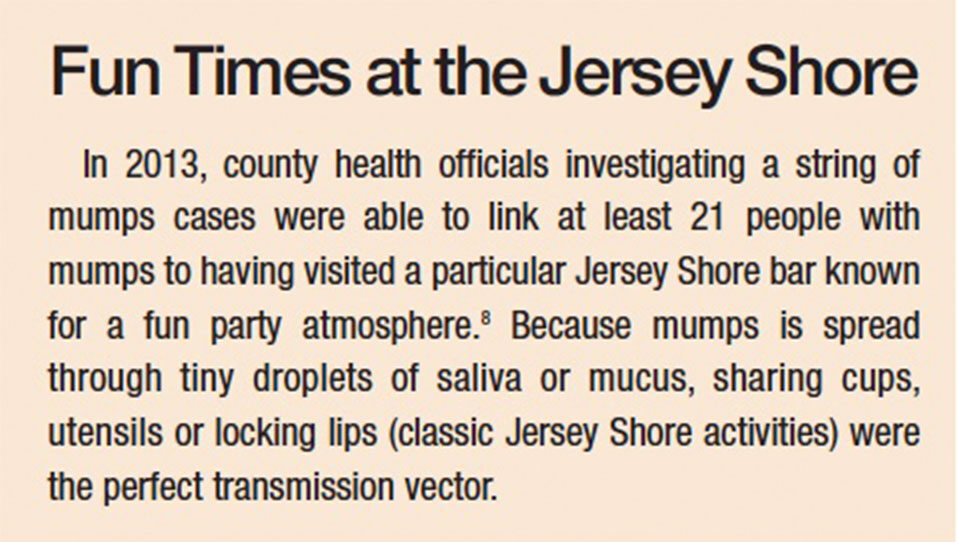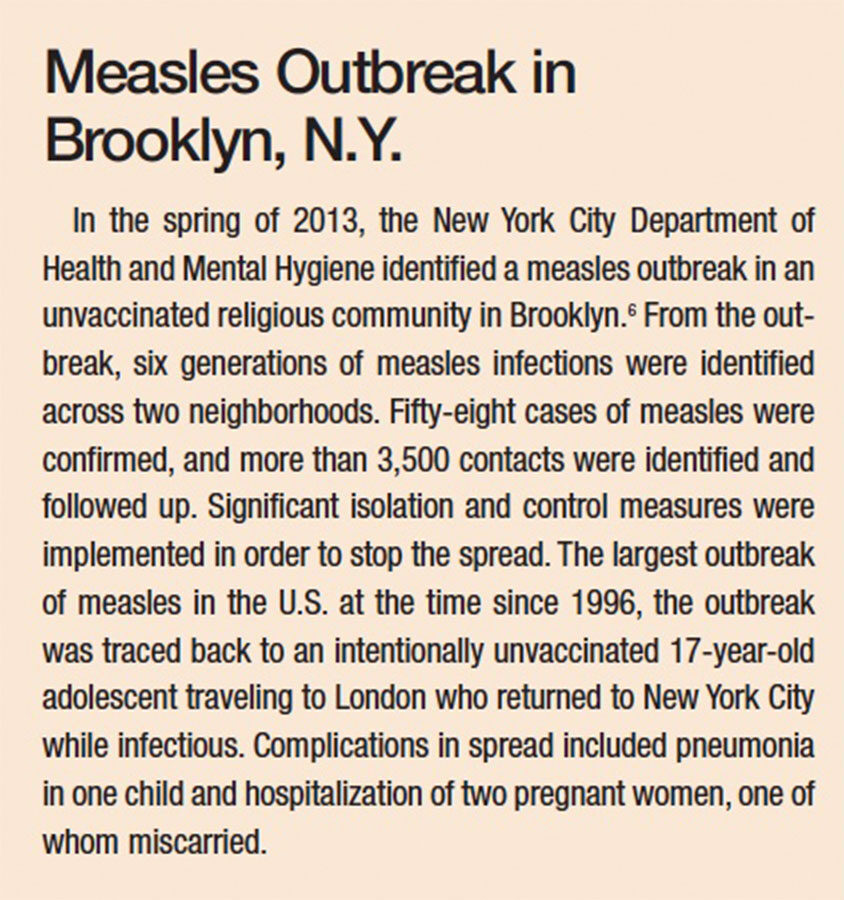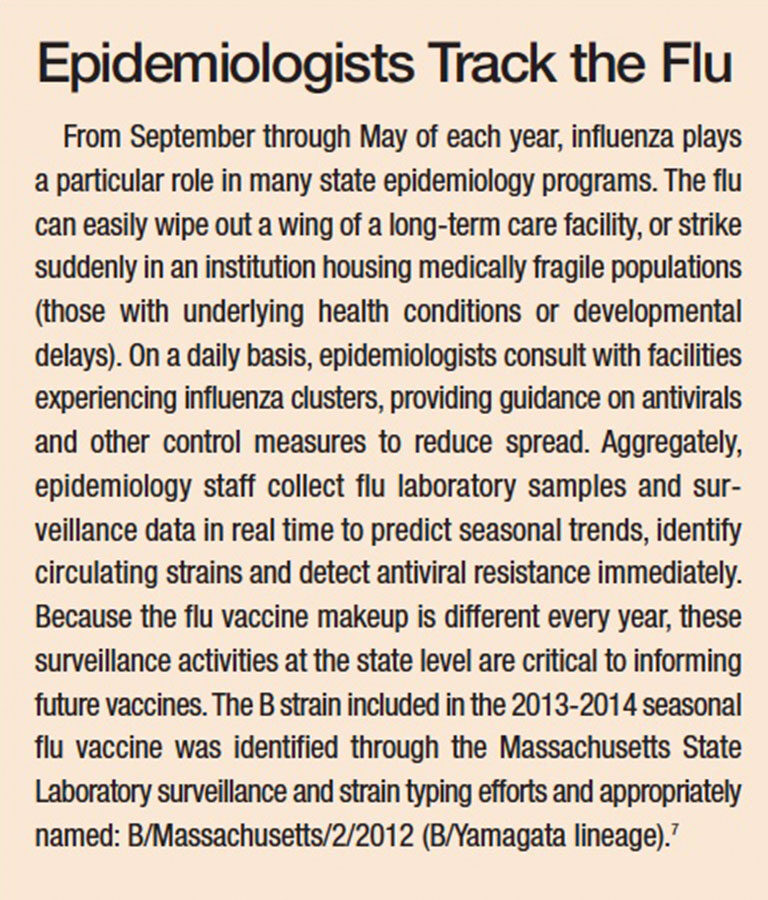Containing an Outbreak: An Epidemiologist at Work
A look at how an epidemiologist conducts an investigation into a measles outbreak shows just how complicated containing an outbreak can be.
- By Hillary Johnson, MHS
Yes, hello. We just admitted an infant with an upper respiratory infection, difficulty breathing, fever of 103, injected eyes and full body rash.
And so it begins.
In a typical day, my office can receive dozens of calls like the one above, and these become suspect cases. In the preliminary case status, a patient might be exhibiting clinical symptoms of a disease, but we do not yet have all the pieces of the puzzle (laboratory test results, travel history, vaccination history, exposure history, possible alternative diagnoses in the differential, etc.) to confirm or revoke it.
As an epidemiologist in a state health department, I am tasked with facilitating the testing, diagnosis and control of diseases deemed dangerous to public health. I am part of an experienced team that focuses exclusively on vaccine-preventable diseases — particularly any of the bugs normally prevented by the standard childhood vaccination schedule. If the disease is rare nowadays because it has a perfectly viable preventive measure (vaccination), then my team will probably participate in some part of the investigation.
In an ideal scenario, a medical provider calls us for direction while the patient is still present. The provider then collects the appropriate specimens, sends them to the state lab and correctly isolates the patient while results are pending. In the worst-case scenario, we are tracking down a patient after their doctor’s visit to collect specimens and more information. In reality, it is usually somewhere in between.
The Case
A family races to their pediatric office, concerned over their little one’s spiking fever and sudden rash spreading down her body. They pace in the waiting room until the pediatrician is available, then dash into the exam room, where the doctor determines the child is in respiratory distress and her fever too high for comfort. The child is then rushed to a hospital via ambulance, where she is eventually triaged in an emergency room and admitted to a pediatric ward. A day later, the child’s serology results show she is IgM positive for the measles virus.
Measles Outbreaks Can Involve Some of the Most Comprehensive Follow-up
Once our team is notified of pending or confirmed test results, we spring into action, gathering as much information as possible. Measles is one of the most highly transmissible vaccine-preventable diseases, and the measles virus can stay in the air up to two hours after the original patient has vacated the room. A viral respiratory illness, it can lead to ear infections, pneumonia, encephalitis and even death, particularly in young children. Susceptible pregnant women exposed to measles risk premature birth or miscarriage.1 While no longer endemic in the U.S., on an average day, 430 children (18 every hour) die of measles worldwide. In 2011, there were an estimated 158,000 measles deaths globally.2 The U.S. saw 189 cases (11 outbreaks)3 in 2013, and 2014 is already well on its way to surpassing that with 108 nationally reported cases as of April 5 this year.4
To prevent further spread, we must act, and act quickly. MMR (measles, mumps, rubella), the measles vaccine, may serve as post-exposure prophylaxis or possibly modify the clinical course of disease if administered within the first 72 hours after exposure.5 The MMR vaccine is highly effective at preventing disease, and certainly in states like Massachusetts, with high vaccination rates, most people are immune as a result. However, recent trends in alternative and delayed vaccine schedules, an increasingly mobile global population, and the occasional adult who missed routine vaccination efforts as a child mean that assumptions cannot be made. Identifying who was exposed and who is susceptible (requiring clinical intervention) becomes priority number one. Immunity is determined by two documented doses of MMR on record, or a blood test showing immunity through the presence of IgG antibodies (either the result of vaccination or previous disease).
Some contacts are easy to identify; the child’s immediate family is quickly cleared. The older siblings are on schedule and have their two documented doses, and serology testing shows the parents are immune. But who else has been exposed?
Tracing the Patient’s Steps
In a small practice like the pediatrician’s office where the child was first seen, everyone present when the child arrived, up to two hours after she left, would be considered exposed.
Working with the office administrators, we pull the day’s appointment list, identifying any overlapping appointment times to ascertain potential contacts. Approximately 11 scheduled children make the list. Four children are infants, too young for vaccination (including one a mere 14 days old). Because the MMR vaccine is not an option, these vulnerable children must immediately receive immune globulin (IG) to reduce their risk for infection and complications. The other seven children exposed have their vaccine records assessed. Those with two doses of vaccine on record are good. Those with only their first dose are scheduled to come in for their second right away.
But we are not done.
If you are following the details of this exposure, you will note that 11 children had pediatric appointments during our exposure hours. But how many children do you know attend their pediatric appointments on their own? We have only a list of those with appointments; we do not know who else accompanied them to the pediatrician’s office and was also exposed.
Every child’s caregiver is contacted to identify if additional parents, siblings or companions were also exposed during the child’s visit. These interviews with caregivers reveal an additional 26 adults and children were exposed. Many of the siblings also have vaccine records at the pediatrician’s office, so their status is quickly determined; however, many of the adult companions must contact their own primary care physicians, or quickly go in for vaccine and/or blood tests. All the while, time is ticking by.
Our original patient rode in an ambulance on her way to the hospital, and ambulatory staff plus any patients driven in the subsequent two hours also need their immunity status checked.
The hospital becomes the biggest and most arduous task. Working with hospital infection control staff, lists are drafted with overlapping patients in the emergency room and the pediatric ward. But this is a large hospital with departments and wards and hallways and people moving all about. Our index patient is highly infectious. Even if she stayed in one location, unless she had been in a negative air pressure room (she hadn’t), anyone in shared airspace was at risk. Hospital engineers are called in to meet with us and discuss building airflow design. Going over HVAC schematic drawings, we determine the shared airspace was limited to the emergency department, pediatric ward and a neighboring radiology suite. Infection control staff are then able to produce a list of exposed patients from the hospital, which starts out at around 400 named individuals. Each of these patients must be contacted and their immunity assessed.
But, here again, this is just the starting point. How many people drive themselves to the emergency room? How many pediatric patients never have a guardian or visitor accompany them? As companions are identified, the list of exposed individuals grows and grows.
Whenever there is a medical facility exposure, we worry about patients, but we also worry about staff, the first line of defense for patients. The Centers for Disease Control and Prevention (CDC) recommends that all healthcare staff are up-to-date with their vaccines and have their immunity status documented and on record with their employer. When medical facilities have prepared this information ahead of time, they are not struggling in an emergency to determine not only exposed patients but also susceptible staff that will then need to be excluded from work. Sadly, in our experience, not every medical facility is prepared for such events. Infection control staff can end up spending hours and even days following up on potentially hundreds of exposed hospital staff. This high-risk occupational setting means that nonimmune staff must be excluded from work almost immediately to prevent putting the facility at further risk.
The Extent of Exposure
Patients with measles are infectious beginning four days before through four days after their rash begins. A patient’s medical visits are often the easiest thing to track. However, their other activities before their diagnosis also need to be examined. In the case of our young child, further inquiry determines she was unvaccinated (due to age), and her family had traveled abroad around the time she would have acquired the infection. On her return to the U.S., her illness began. Based upon her infectious period, international and domestic flights had been exposed. This requires coordination with CDC and U.S. quarantine stations to obtain flight manifests and notify the other states and countries involved. We must drill down to the exact seat our patient sat in, as airflow patterns on a plane may vary, and quarantine stations need to determine who exactly had been exposed and should be notified.
What Happens When a Contact Is Not Immune?
Exposed individuals who do not have evidence of immunity (either through vaccination records or a blood test) and who do not receive the vaccine immediately (either because we could not contact them early enough or they refused vaccination) must be excluded from public activities through a full incubation period (the period of time when they may potentially develop disease). For measles exposure, quarantine would begin on the fifth day after exposure and continue through the 21st day. During this time, children must stay home from group daycare facilities or schools, and adults must stay home from work. It can undoubtedly be a burden, not to mention the obvious stress associated with watchful waiting and the chance one might get sick. But such exclusions help to stop the spread of disease by reducing the possibility of further exposure, and they have been the cornerstone of public health disease intervention for generations.

Emerging Technology Can Aid an Investigation
If epidemiology was the subject of a primetime investigative television drama, our office would have touch screen computer systems and a tech-savvy Goth girl in pigtails hacking into every surveillance system or video camera in the city, tracing an index case’s every step and easily identifying every location of exposure.
Reality is much more sobering. My computer monitor rests on a stack of medical textbooks, and my operating system is still an antiquated Windows XP. I do not have caller ID on my office phone, and I do not get free coffee. This is true government work. But, while we do not have cutting-edge office resources, the field is still benefiting from technology in several ways.
One of our measles cases this year traveled from several locations via taxicabs. Previously, without the case being able to identify the taxi drivers (would you remember the name and contact information for your last cab driver?), these would be considered lost to follow-up. However, because our case had utilized a new mobile app to order three of her cab rides, she was able to produce email receipts with cab driver names, contact information and exact pick-up and drop-off times. With that information, we were able to contact the mobile app company and identify the exposed drivers, as well as any clients picked up within the next two hours. Drivers and subsequent clients were all able to receive follow-up and vaccination as needed. Such mobile and GPS technologies are assisting in disease intervention more and more.
It’s All in the Timing
Every vaccine-preventable disease differs in transmissibility, infectiousness and follow-up. With measles, the timing for intervention is very specific. For a disease like pertussis, the window for preventive prophylaxis is much larger. But, they all require the same thorough diligence and partnerships with medical providers, schools and local health officials. Every hour that passes is one hour closer to an exclusion period or may mean a child might not get a preventive dose of vaccine or medication. Sometimes, a patient appears with a clinically classic set of symptoms. Confirmation with test results is immediate, and disease control can begin right away. Other times, the case before us presents more of a challenge. A rash might not have progressed classically, or a normally key symptom may be missing in the clinical picture. Sometimes, you may be convinced the patient in front of you has measles, but then it comes to light that three other children who attend the same daycare were just diagnosed with hand, foot and mouth disease (and there’s your real answer). Or, a patient eventually reveals that he recently started a new medication, and the rash started shortly thereafter (suddenly an allergic reaction is much higher on the differential).
These additional details are critical as we wait for laboratory confirmation of a case: Has a patient engaged in recent travel? If not, have they had any foreign visitors recently? Is anyone else at work sick? Is the patient vaccinated? Any of these answers can help sway an investigation, and they are particularly important when laboratory test results are questionable. Our lab once received a nasopharyngeal swab from a provider office that tested negative, even though the clinical picture and background information on the patient was highly indicative of disease. This didn’t sit right. Further investigation revealed the swab had sat “lost” on a shelf at the medical office for several days before someone found it and sent it in to the state lab. With unclear specimen handling and cold chain history, the specimen had been unsatisfactory for testing, and a negative result was not a surprise. Timing of specimens is also critical. If collected too early, a serology might be falsely positive because IgM antibodies have not yet mounted in sufficient quantities. If collected too late, a nasopharyngeal swab might not pick up enough virus to show up on a PCR test or culture.

In a fictional primetime TV drama, test results would be immediate and black or white. In reality, testing and retesting may be required. The decision to initiate a public health response is a judgment call based upon balancing the information at hand vs. the dangers of delaying follow-up. When lives are on the line, there is little room for error.
All told, our team spent the next month following up on more than 600 exposed individuals. Thanks to the combined efforts of medical facility staff, local health officials and several vaccination clinics, this exposure did not lead to any secondary cases. Countless individuals had to be vaccinated, and many were excluded from public activities through a full incubation period to help stop the spread.
The full follow-up from an outbreak can take weeks, particularly if there are second and third generations of disease (or six, as in the 2013 measles outbreak in Brooklyn, N.Y.6). Larger vaccination campaigns and follow-up may be required, and additional control measures may be implemented as needed. While not every suspect case under investigation pans out into confirmed disease and requires such intensive contact tracing and follow-up, epidemiologists must be ready and able to respond if they do.
Hello, we have a hospitalized patient with a high fever who seems to be developing a rash on his trunk. He’s febrile and showing signs of fatigue, rhinorrhea and myalgia. He just came back from a hiking trip in a highly Lyme-endemic area where he was exposed to many ticks. We are pretty sure this is Lyme disease, but his wife is pregnant so we’d like to send in a serology for measles and rubella testing to the state lab just to be cautious.
Here we go again.
References
- Centers for Disease Control and Prevention. Overview of Measles. Accessed at www.cdc.gov/measles/about/overview.html.
- Centers for Disease Control and Prevention. (2013) Measles Still Threatens Health Security. Press Release, Dec. 5, 2013. Accessed at www.cdc.gov/media/releases/2013/p1205-meales-threat.html.
- Centers for Disease Control and Prevention. Measles Outbreaks. Accessed at www.cdc.gov/measles/outbreaks.html.
- Centers for Disease Control and Prevention. Notifiable Disease and Mortality Tables. Morbidity and Mortality Weekly Report, April 11, 2014, Vol. 63, No. 14. Accessed at wonder.cdc.gov/mmwr/mmwr_reps.asp?mmwr_year=2014&mmwr_week=14&mmwr_table=1&request=Submit.
- Centers for Disease Control and Prevention. Prevention of Measles, Rubella, Congenital Rubella Syndrome, and Mumps, 2013: Summary Recommendations of the Advisory Committee on Immunization Practices (ACIP). Morbidity and Mortality Weekly Report, 2013; 62(RR04):1-34.
- Centers for Disease Control and Prevention. Measles Outbreak Among Members of a Religious Community — Brooklyn, New York, March-June 2013. Morbidity and Mortality Weekly Report, 2013; 62(36);752-753.
- Centers for Disease Control and Prevention. What You Should Know for the 2013-2014 Influenza Season. Accessed at www.cdc.gov/flu/about/season/flu-season-2013-2014.htm.
- Moisse K. Mumps Outbreak Tied to N.J. Bar. ABC News, Sep 5, 2014. Accessed at abcnews.go.com/blogs/health/2013/09/05/mumps-outbreak-tied-to-n-j-bar.
